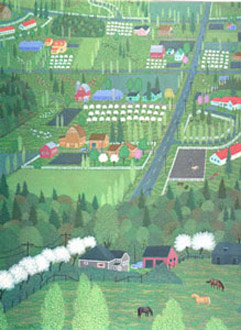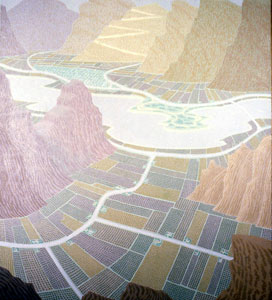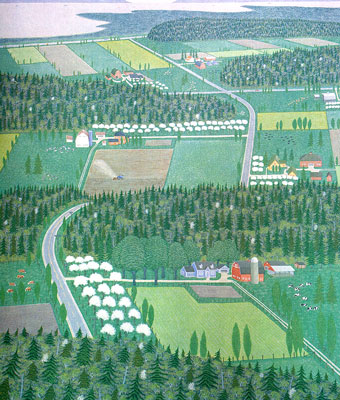
|
|
My paintings are my dream of a possible future. Although they frequently derive from specific locations or combinations of several sites, the structures of the paintings are imaginative. Because my motifs are small family farms--current or remembered--they may evoke feelings of nostalgia. If my paintings hearken back, it is only to discover values we must embrace if there is to be a future. We must learn to live gently with the land.
Artists and their advocates quarrel about what is most important in a work of visual art. Some argue that intellectual concepts imbedded in the subject matter or imagery are primary. Opposite are those who contend that only abstract, formal qualities peculiar to visual art are significant, going so far as to condemn subject matter, imagery and illusion as contaminants in painting and sculpture.
We can isolate and analyze social, political and religious concepts articulated in subject matter or symbolism. We can describe stylistic characteristics--whether a work is linear or painterly, organic or geometric, aggressive or gentle. We can identify styles of individual artists. Scholars spend lifetimes establishing connections between artists' styles and their personal histories.
Historically, subject matter has been the point of departure in the creation of paintings and sculptures. It gives focus to feeling. It is what the feeling relates to. Paradoxically, historically and culturally particular subjects and styles are what frequently become irrelevant distractions (or worse) to the experience one hopes to get from works of art. At best, subject matter is universalized and continues to be integrated in the "life" of a work as, for instance, a "Madonna and Child" by Bellini, serves as a metaphor for the wider mother/child experience or as a portrait by Rembrandt is a metaphor for the individual or as a painting of Mt. St. Victoire by Cezanne stands as a symbolic world-view.
The stylistic character of my paintings is likewise apparent. They are orderly without being analytic, i.e. there is no scientific perspective or objective realism. They are painted with patience and care. Forms are softened and colour harmonies muted. They express a gentle, intelligent and caring involvement with the land. They are about an attitude, perhaps like that of a good gardener.
|
 TO LIVE GENTLY WITH THE LAND
TO LIVE GENTLY WITH THE LAND  In my view, in a good work of art everything is assimilated into the artist's vision or idea of feeling which is the germ of the creation. The subject matter, symbolism, narrative, stylistic character and expressive form add up to its' "life". It has unity resembling a living organism. Wholeness, life pervades all its' parts.
In my view, in a good work of art everything is assimilated into the artist's vision or idea of feeling which is the germ of the creation. The subject matter, symbolism, narrative, stylistic character and expressive form add up to its' "life". It has unity resembling a living organism. Wholeness, life pervades all its' parts.  What I have called "life" is the quality which eludes analysis and explanation. In some mysterious way good works of art appear to hold or embody feeling. We are aware of its presence. We experience it. We can empathize with it. We may be moved by it. We cannot extricate it from forms or representation. We cannot define it. We do not understand it. It is the quality which allows us to distinguish a mediocre Van Gogh from a great one, or a masterpiece by Rubens from a cliched baroque set-piece.
What I have called "life" is the quality which eludes analysis and explanation. In some mysterious way good works of art appear to hold or embody feeling. We are aware of its presence. We experience it. We can empathize with it. We may be moved by it. We cannot extricate it from forms or representation. We cannot define it. We do not understand it. It is the quality which allows us to distinguish a mediocre Van Gogh from a great one, or a masterpiece by Rubens from a cliched baroque set-piece.  The meaning of my subject matter is easy to understand. Farms intermingle with woodlands and wilderness to suggest an idyllic integration between man and nature. These are small farms where mixed farming is practiced. The land is nurtured. Domesticated animals live out their lives in fulfillment of their natures. Such farms are the antithesis of today's mechanized mono-crop farms, where the soil is pillaged in exchange for short-term high crop yields and to animal factory farms where cattle never graze nor pigs root or chickens scratch. Such hi-tech farming practices exemplify mankind's lack of empathy for the rest of life.
The meaning of my subject matter is easy to understand. Farms intermingle with woodlands and wilderness to suggest an idyllic integration between man and nature. These are small farms where mixed farming is practiced. The land is nurtured. Domesticated animals live out their lives in fulfillment of their natures. Such farms are the antithesis of today's mechanized mono-crop farms, where the soil is pillaged in exchange for short-term high crop yields and to animal factory farms where cattle never graze nor pigs root or chickens scratch. Such hi-tech farming practices exemplify mankind's lack of empathy for the rest of life.